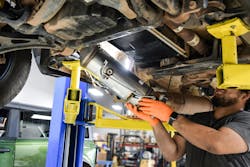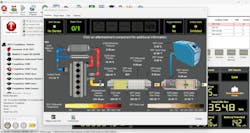Deleters never prosper: Why emissions tampering is still high risk and low reward
In this article, you'll learn about:
- Why a more business-friendly administration doesn't make emissions deleting allowed
- How emissions system tampering is caught and punished
- Why fleets or owner-operators might be tempted to tamper with their emissions system
The current White House and head of the EPA, Lee Zeldin, have made it pretty clear that they aren’t big on regulations, nor on making things harder for businesses than they have to be. As a result, “stopping aftermarket defeat devices” is no longer a top-level priority in the EPA’s 2024-2027 National Enforcement and Compliance Initiative. Add all of that to the personnel cuts that could end up slicing through the agency, and some fleets might be lulled into thinking that diesel deleting—removing or bypassing emissions systems components such as the diesel particulate filter or exhaust gas recirculation system—is something they could get away with now.
Those fleets might want to think again.
“I don’t believe the EPA is going to back off of the federal regulations that are already on the books,” said Bruce Balfour, vice president of Clean Diesel Specialists (CDS), a diesel emissions service and equipment company with a nationwide network of owned and affiliated shops. “As of now, it’s still 100% illegal to modify an emissions system.”
The EPA makes it pretty clear: Don’t tamper with or install kits to defeat emissions systems.
As per the Clean Air Act Title 40, Ch. 1, 1068.101, tampering is defined as “remov[ing] or render[ing] inoperative any device or element of design installed on or in engines/equipment in compliance with the regulations” before or after sale. The EPA may levy a $45,268 penalty for each engine or part in violation. Certain circumstances, such as during a repair or emergency modification, are excluded, according to the code.
If you “knowingly manufacture, sell, offer to sell, or install, any component that bypasses, impairs, defeats, or disables the control of emissions of any regulated pollutant,” you could be assessed a $4,500 fine in each instance found. The EPA could take another $45,268 per day for reporting and record-keeping violations.
And just in case you’re thinking it’s only an issue in deep blue states like California, Oregon, Maryland, and Massachusetts, here are some past EPA emissions-cheating cases from across the U.S. to prove that diesel cheaters never prosper:
- Roughly 16 enforcement cases were resolved in 2024, including a shop in Nebraska that agreed to a civil penalty of over $670,000.
- Over 40 cases were resolved in 2021, including those regarding a Texas trucking company that settled for nearly $14,000, a Pennsylvania trucking company that settled for around $50,000, and an Indiana shop that was hit with an $80,000 penalty.
- Nearly 50 cases were resolved in 2019 during Trump’s first term, including a Texas shop that was hit with a penalty of over $30,000.
- Over 30 cases were resolved in 2017, the first year of Trump’s first term, including a shop in Wisconsin that consented to nearly $20,000 in penalties.
Another factor to consider is that aftertreatment systems are already baked into the engineering formula for diesel truck manufacturers.
“I don’t see the Trump administration doing anything to reverse the emissions regulations that already exist,” said Steve Hoke, president of Diesel Emissions Service (DES), a provider of parts and service with four DPF cleaning facilities covering the West Coast. “To make a model change, a truck or engine manufacturer spends millions of dollars over a five- to eight-year planning period. So, any loosening of emissions regulations won’t be retroactive, in my opinion.
“The Trump administration might kill the 2027 greenhouse gas rule, but trucks will still need aftertreatment systems to maintain compliance with current regulations,” he continued. “It’s not going to turn into the Wild West like some truckers are thinking it will.”
According to Balfour, emissions tampering has also lost much of its appeal over the past five to 10 years as aftertreatment systems have gotten considerably better. But tampering is still going on in certain places, particularly in states or counties that don’t require emissions testing. But even in those areas, the EPA and its state and local partners still have the authority to enforce the law, in this case the EPA’s Clean Air Act.
“Spot inspections happen a couple of different ways,” said Paul Wilson, social media and marketing supervisor at Calibrated Power Solutions, a data-driven tuning business and home of DuramaxTuner.com. “An inspector could plug into the diagnostic port on the vehicle and scan for codes. In Illinois, where we are based, you also see a lot of snap tests on a dynamometer. That is a great way to get a diesel truck to puff some smoke. Inspectors may also look around to see if there’s a DPF, for example.”
Roadside inspectors may also utilize an opacity meter to test the amount of soot coming out of the tailpipe, Balfour added. They may even place a borescope down the tailpipe to see if any of the filter substrates have been removed.
The question some fleets are asking themselves is: What are the chances of getting caught nowadays? According to folks like Balfour, Hoke, and Wilson, those odds are far too great for fleets to take a chance.
Just look at what prior EPA crackdowns have produced—including during Trump’s first term. In fact, a press release from the Trump administration in October 2020 highlighted how Trump’s first EPA assessed more criminal fines, civil penalties, and restitution than the first four years of the Obama administration. (Selective catalyst reduction and diesel exhaust fluid started getting phased in a year after Obama took office). The statement specifically mentioned emissions cheat devices as an area that contributes to violations of air quality standards and negatively impacts American citizens. This shows how an administration’s abhorrence of burdensome regulations can conflict with a parallel loathing for the disregard for law and order.
The EPA has also cracked down hard on diesel tuner manufacturers. In fact, Calibrated Power Solutions got hit in 2024 after it was discovered that one of its tuning devices could allow EGR disablement on older GM Duramax Diesel trucks. Numerous other tuner manufacturers have also been penalized, including Derive Systems (Bully Dog and SCT brands), Edge Products, Performance Diesel, Power Performance Enterprises, Sinister Diesel, Thoroughbred Diesel, VMP Tuning, and others. Some of the penalties have climbed into the millions of dollars.
What drives the desire to delete?
During the pre-2014 era of diesel aftertreatment systems, the desire to delete was often driven by the desire for more horsepower and fuel economy. Those pain points went away, for the most part.
“Once the GHG standard was introduced in 2014, the focus shifted from reducing NOx emissions to lowering CO2 levels,” said Jason Hedman, product manager at Noregon, a provider of diagnostic tools and solutions. “The only way to lower CO2 was to increase the fuel economy. To a certain extent, more horsepower can contribute to better fuel economy. So, with the start of the GHG standard, vehicles saw an increase in both horsepower and fuel efficiency.”
As proof, a Duramax Tuner worked with a 2015 GMC 2500HD Denali owned by David Schaefer to get 700 hp and still remain emissions compliant and, according to the company, still maintain “factory-like regen intervals.” It’s nicknamed the Time Bomb, and the power/emissions balance was achieved with a S372SXE turbo, Exergy injectors coupled with a 10mm CP4 pump, and a WCFab custom air intake kit and WCFab twin turbo high-flow up pipes with an EGR leg. The factory transmission was also swapped for one built by Cold Front Diesel with a 750 hp capacity.
But as they have done in the past, some truck owners today still want to delete. In most instances, aggravation with various aftertreatment system components provides all the motivation that’s necessary. Sometimes, the motivation is born out of fear.
“Years ago, people deleted emissions systems because those systems failed and it was going to cost a lot of money to fix,” Wilson said. “It was cheaper to delete than repair, so it seemed logical. Nowadays, the people who are still thinking about deleting are simply worried about something failing. Emissions equipment has become wildly more reliable, though. We see far fewer EGR and DPF failures. DEF systems still have their issues, but it’s usually something affordable like a sensor. But it doesn’t matter to some truck owners. They are simply afraid of something failing.”
Wilson said fleets running smaller trucks and vans are more likely to be fear-driven. They operate in a lot of stop-and-go traffic, which can be hard on aftertreatment systems. When a fleet gets hammered with an expensive tow bill due to a failed emissions system, that only fuels their desire to delete even more.
Jacob Lopez, the service manager at Bullet Proof Diesel, agrees. The repair shop in Mesa, Arizona primarily services diesel pickup trucks, some of which are in vocational-type applications that are also hard on aftertreatment systems. If a truck ever comes in for service with deleted emissions equipment, Lopez’s team will not work on it. That doesn’t happen very often anymore, however.
“The tuning you need to do to make a truck drivable after a delete has pretty much been shut down now,” Lopez said.
The likelihood of encountering deleted emissions systems is even smaller among Classes 7 and 8 fleets, particularly tractor-trailers. But it’s not completely unheard of.
“The most likely scenario is a second or third owner with a truck over 400,000 miles that’s no longer under warranty,” Balfour said. “Owner/operators and small fleets are the most likely to still want to delete.”
Hoke agrees, adding that third owners with 10-year-old trucks represent the most likely deletion candidates.
“Second owners are typically small fleets that still keep up with maintenance pretty well,” Hoke said. “But third owners are often owner/operators who typically don’t track numbers like downtime and cost-per-mile. When something goes bad with a DPF, DOC, or SCR, and the dealer says it’s going to cost $20,000 to fix, some of these third owners just want to rip everything off—or try to find a shop that will do it.
“But it’s interesting,” Hoke continued. “I’ve heard of some truck owners spending $5,000 to have an EGR deleted when they could have just replaced it for $1,200. And the thing is, when you use a tune to cheat an emissions system, but still leave the physical components like the DPF intact, it’s still having to catch all of that soot and ash. That’s still going to cause major problems down the road.”
About the Author

Gregg Wartgow
Gregg Wartgow is a freelancer who Fleet Maintenance has relied upon for many years, writing about virtually any trucking topic. He lives in Brodhead, Wisconsin.


